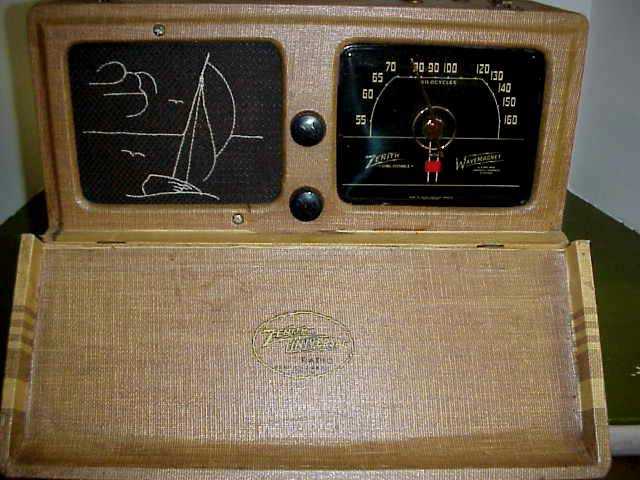Here is my latest Zenith find! A Zenith 6G601M


..and the rear....
This AM-only tube portable is not a TransOceanic. It was designed as a "companion" set to the more powerful (and pricier!) Zenith TransOceanic of 1942. The two radios share the same basic cabinet design, with a patterned grille cloth on the left and a dial on the right. The sailboat grille design is common to this Universal model and few first-run TransOceanics. The tuning dial is black with white lettering and a brass pointer that's one of my all-time favorites. Like many portables of its time, the Universal looks like a little suitcase when closed up. It has a sturdy leather handle and nickel-plated brass clasps to secure front and back covers. The front cover has a "loose" hinge so it can be lifted off after opening. Although convenient for table operation, the loose-hinge feature probably resulted in a certain number of lost covers over time. A sturdy leather handle is mounted on top and the case is covered in "airplane fabric," basically a durable coated linen, with a pattern of contrasting tan and brown stripes. This radio was offered in two other fabric colors, plus brown cowhide and and a brown imitation alligator that's a perfect match for the original TransOceanic. The 6G601M, along with a few other pre-TransOceanic portables, sported the "WaveMagnet" antenna—a large antenna connected to the chassis by a flexible strap and equipped with flexible suction cups. Patented by Commander McDonald, the head of Zenith, the WaveMagnet could be attached to the window of a train, airplane, or boat. Ordinary sets might be silenced inside those mostly-metal vehicles, but you could improve your reception by sticking your WaveMagnet onto the window next to you. The Wavemagnet antenna became one of the hallmarks of the TransOceanic line, enduring in one form or another well into the transistor era. Inside, you'll find six tubes: 3Q5G, 117Z6G, 1LH4, 1LN5, 1LN5, and 1LA6. The radio is powered either from 110-volt current (AC or DC) or from a massive battery pack. (from a description from Phil's Old Radios)
Quite a story, really, to get this thing going. I actually got this rig on E-Bay about 4 months ago, and have been restoring it for all these months. Actually, its in pretty good condition. Check out the "Wave Magnet". It is in really nice shape.
First, I scrubbed the outside with a mild soap (Murphys Oil Soap) and a soft brush. Most of the gunk came off, but it still has that older radio "look". The brass fittings are a bit corroded, but I would say at least 60% of original. Can you redo these things? I suppose, but then I would loose that old radio look. Besides, I don't want to leave old holes from the brads. I tried right away to get 'er up and running and failed. I actually found a schematic but it wasn't very clear where I needed it. The values for the capacitors were really smudged. Oh well, beggars can't be chosers, right? Well, I eventually downloaded a "real" schematic, great resolution, and only $5.00. Well, I decided with the help of an old Zenith pro, Peter Weick, that I needed to replace the rectifier tube. The filament was gone, so that HAD to be it. Sent away to Antique Electronic Supply for the 117Z6G tube, I think it was $4.00. All the other tubes seemed ok, though my handy dandy Heathkit tube tester wasn't exactly conclusive. They say the only REAL way to see if the tubes work is to put 'em in the circuit. Well, that wasn't it, although the tube was now lit. In these rigs, the rectifier tube is the ONLY one you can actually see "glow".
Darn!! Well, it HAD to be the caps, as the sound wasn't anything except for that "these caps are shot" hum that all radio junkies recognize. Well, I didn't really know much about "can" capacitors, so I put it on the back burner. I did get some "orange drops" for some of the caps, but I needed to replace the electrolytics. Much to my dismay, the electrolytics were the "can" ones. I would have to try and tackle the cans.
Off to the catalogues again.. This time it was Mousers Electronics. A definite keeper, this company should be in any amateur radio repair/builders portfolio. I got a whole "bunch" of electrolytics, I decided to get some caps a bit bigger than required, besides, it was hard to find the exact size. The schematics call for 20uF, 25 and 160 V, and also 40uF 25 and 160V. I got 47uH 165V and used them for all of 'em. I had to consult with Peter again; I really didn't want to have to try and take out the old "cans" and replace those..... Well, turned out that I didn't have to. In fact, all I had to do was cut the leads from the cans, and resolder the new caps in.
As I was working on another project, I was reminded that
Anyway, another Zenith success story. I really love these old glowbugs. I wish I could share the history and the great smell of these radios. Got to go now, working on another project.